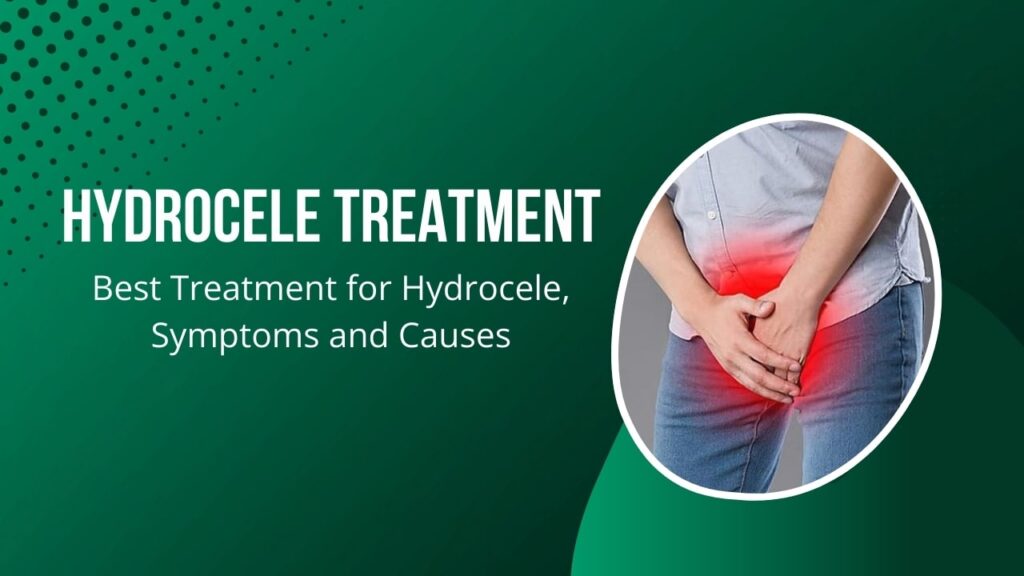Last updated on May 21st, 2025 at 12:34 pm
 Hydrocele treatment typically involves surgical options like hydrocelectomy, where the fluid-filled sac around the testicle is removed, or needle aspiration to drain excess fluid. Medication may be prescribed to manage symptoms like pain and inflammation, but surgery is often the most effective long-term solution for hydrocele.
Hydrocele treatment typically involves surgical options like hydrocelectomy, where the fluid-filled sac around the testicle is removed, or needle aspiration to drain excess fluid. Medication may be prescribed to manage symptoms like pain and inflammation, but surgery is often the most effective long-term solution for hydrocele.
Hydrocele is a common condition that affects males, occurring when fluid accumulates in the sac around the testes, causing swelling. While it’s generally not painful, it can be concerning for individuals experiencing it.
What is Hydrocele?
Hydrocele is characterized by the accumulation of fluid in the sac surrounding the testes, called the tunica vaginalis. This fluid buildup leads to swelling in the scrotum.
Although it can affect males of any age, it’s most commonly found in newborns, typically resolving without treatment within the first year of life. However, hydrocele can also develop later in life due to various reasons.
Causes of Hydrocele
The primary causes of Hydrocele are mentioned below:
- Congenital: In newborns, hydrocele often occurs due to the failure of the connection between the abdomen and the scrotum to close properly during development.
- Injury or Infection: Trauma or infections in the scrotum or groin area can lead to the development of hydrocele.
- Inflammation: Inflammatory conditions such as epididymitis or orchitis can cause fluid accumulation.
- Blockage: Blockage or damage to the lymphatic system can hinder the drainage of fluid from the scrotum, leading to hydrocele.
- Idiopathic: In some cases, the cause of hydrocele may not be apparent, and it’s termed idiopathic hydrocele.
Symptoms of Hydrocele
The primary symptom of hydrocele is swelling in the scrotum and it may vary in size. Other symptoms may include:
- Heaviness or discomfort in the scrotum
- Feeling of pressure in the groin area
- Enlargement of the affected testicle
- Difficulty in walking or performing physical activities in severe cases
> Consult a Doctor and Medkart will help you Order Medicines Online
Hydrocele Treatment
The best treatment of hydrocele are mentioned below:
Observation: In newborns, hydrocele often resolves on its own within the first year of life without any intervention. Doctors may advise monitoring the condition and opting for treatment only if it persists or causes discomfort.
Medication: In cases where hydrocele is caused by infection or inflammation, such as epididymitis or orchitis, antibiotics or anti-inflammatory medications may be prescribed to alleviate symptoms.
Aspiration (Needle Drainage): In this procedure, a needle is inserted into the scrotum to drain the accumulated fluid. While this provides temporary relief, there’s a risk of recurrence, and it’s not considered a permanent solution.
Hydrocelectomy: Hydrocelectomy is a surgical procedure performed to remove the hydrocele sac. It’s typically recommended for large or symptomatic hydroceles that do not resolve on their own or through other treatments. During the procedure, the surgeon makes an incision in the scrotum or groin, drains the fluid, and removes the sac. This is a relatively safe and effective procedure with a low risk of complications.
Sclerotherapy: In this minimally invasive procedure, a sclerosing agent is injected into the hydrocele sac to cause it to shrink and eventually close off. It’s often used as an alternative to surgery, particularly in cases where surgery poses a higher risk or for individuals who prefer a less invasive option.
Read: What are Generic Medicines?

Conclusion:
Hydrocele is a common condition characterized by fluid accumulation in the sac surrounding the testes, leading to scrotal swelling. While it’s usually harmless and resolves on its own in newborns, it may require treatment in some cases, especially if it causes discomfort or persists into adulthood.
Treatment options range from observation and medication to minimally invasive procedures like aspiration or sclerotherapy, and surgical intervention with hydrocelectomy. Consulting a healthcare professional is essential for proper diagnosis and determining the most appropriate treatment approach based on individual circumstances.
FAQs on Hydrocele Treatment
Q1. What is Hydrocele Treatment?
Hydrocele treatment typically involves surgical intervention to remove the fluid-filled sac around the testicle, known as a hydrocelectomy. Alternatively, needle aspiration may be performed to drain the excess fluid, although this method often results in temporary relief. In some cases, medication may be prescribed to manage symptoms such as pain and inflammation, but surgery remains the most effective long-term solution.
Q2. Can hydrocele be treated with medication alone?
Medication can help manage symptoms such as pain and inflammation associated with hydrocele, but it typically doesn’t resolve the condition itself. Surgery is often necessary for a permanent solution, especially if the hydrocele is large, causes discomfort, or persists over time.
Q3. What surgical options are available for hydrocele treatment?
Surgical options for hydrocele treatment include hydrocelectomy, a procedure where the excess fluid is drained and the sac causing the fluid buildup is removed. Another approach is needle aspiration, where a needle is used to drain the fluid from the scrotum. However, aspiration is often temporary and may require repeated procedures.
Q4. How long does it take to recover from hydrocele surgery?
Recovery time can vary depending on the individual and the type of surgery performed. In general, most people can return to normal activities within a few days to a week after surgery. However, it’s essential to follow the surgeon’s post-operative instructions carefully to minimize complications and ensure proper healing.
Related Links:
- Hand Foot and Mouth Disease Treatment
- Gastritis Treatment
- Frozen Shoulder Treatment
- Fever after Covishield Vaccine Treatment
- Dry Cough Treatment
- Endometriosis Treatment
- Dog Bite Treatment
- Breast Cancer Treatment
- PCV in Blood Test
- Normal Hemoglobin Level in Female
